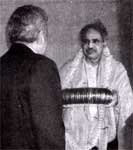

INFORMATION TECHNOLOGY FOR CULTURAL LEARNING
BY SANJAY GOEL
REPORTS – IGNCA organized a conference on “Information and Communication Technologies for Cultural Learning and Distance Education” in collaboration with Manipal Institute of Information Technology (MIIT), on March 24-25 in Bangalore. The two-day conference, under the sponsorship of UNDP was an attempt to bring to focus various debates relating to digitization of cultural resources and to raise relevant methodological and epistemological issues. Some of leading IT experts, domain experts and planners shared their experiences at this conference. IGNCA and initiated a dialogue on these issues at an international conference on “Multimedia for the Humanities” held in 1998, in New Delhi. That meet too was sponsored by UNDP.
Realizing the potential of information technology in the area of arts and culture, IGNCA had started a project, with UNDP, way back in 1995 on “Interactive Multimedia Documentation of Cultural Resources.” As part of this initiative a new group called “Cultural Informatics Lab” was set up to carry out certain experiments and develop some prototypes in this area.
The Bangalore conference was inaugurated by Prof. Raj Reddy of Carnegie Mellon University who is spearheading an ambitious project on Universal Digital Library to make one million books available on Internet. Prof. Reddy also released the IGNCA CD on ‘Muktesvara Temple.’ In his inaugural address, Prof. Reddy said the digital libraries would eliminate the constraints of time, space and cost and facilitate rapid democratization of access to information. With regard to the question of depth vs. breadth of information to be put on the digital libraries, he expressed his preference for the wider coverage in the first phase. Responding to the controversy of direct digitization vs. microfilm based digitization of old manuscripts, he favoured direct digitization at high resolution. His talk was followed by a brief presentation of IGNCA website, and CD-ROMs on ‘Muktesvara Temple’ and ‘Visvarupa.’ Congratulating IGNCA for its achievements, Prof. Reddy expressed his desire to have collaboration between the Carnegie Mellon University and IGNCA.
Dr. S.P. Mudur, NCST made a presentation on “Large Model Visualisation Techniques for Heritage Monument Walkthrough”. – He demonstrated a well-made 3D interactive walkthrough to Fatehpur Sikri. Dr. Ramakrishnan, Ministry of Information Technology (MIT) made a presentation on “Media Lab Asia – Emerging Vision”. He explained that the Media Lab Asia, being set up in collaboration with Media Lab, MIT will work towards bringing high technology to the masses and rural people for learning, business, health and so on. The next session started with a talk by Mr. H.R. Mohan, from ‘The Hindu’ on “Digital Library for Newspaper” in which he shared his experiences and future plans of his newspaper. He also talked about the “Current India Initiative” for creating digital archive of editorial content of Indian newspapers. Mr. Sunil Jha, CEO of iCMG speaking on “Marching towards E-Learning” said it goes far beyond digitization and should not be reduce to conversion of books into HTML format. Prof. Choodamani Nandagopal of Chitra Kala Parishad, who talked on the “Scenario of Digitizing the Art Object and Heritage Sites” said there was an urgent need to create awareness among people working the field of museum regarding the digitization process.
On the second day, Mr. Pratap Hegde, Infodesk Manipal Ltd., gave on overview of GIS technologies and applications. He gave various examples of GIS applications in tourism, forestry, crime control, energy transmission and so on. Mr. Arun Vardrajan of Vlin U proposed a learning framework for collaborative and organized learning. This was followed by a presentation by Prof. N. Chandrasekharan, MIIIT on “Technologies for Digital Libraries”. He gave a broad overview of the existing and upcoming technologies.
Dr. Mukul Sinha of Expert Software Consultants spoke on “From teaching to learning.” He discusses various strengths and limitations of class-room teaching and said internet has led to a change in education demand and there was a push to E-learning for overcoming some of the disadvantages of classroom teaching. Dr. H.K. Kaul, Librarina, Indian International Centre, who talked on “Digital Library – selection of material for scanning” felt that there was need for coordination at global level so that publication of the effort may be avoided. In the last session, Sanjay Goel, IGNCA gave a talk on “A model of multimedia cultural learning system” in which he presented a model of quality metrics and cognitive maps for such systems. Mr. Ajay Gore, NCST who along with his colleagues discussed about various features of “Vartalaap” a software tool developed by NCST for creating virtual classrooms.
The conference thus provided a forum for promoting synergies between the disciplines of IT, Cultural studies and Library Sciences, and evolved answers to some very important questions and helped in developing strategies for future collaborations.
[ Newsletter | List of Newsletter ]




